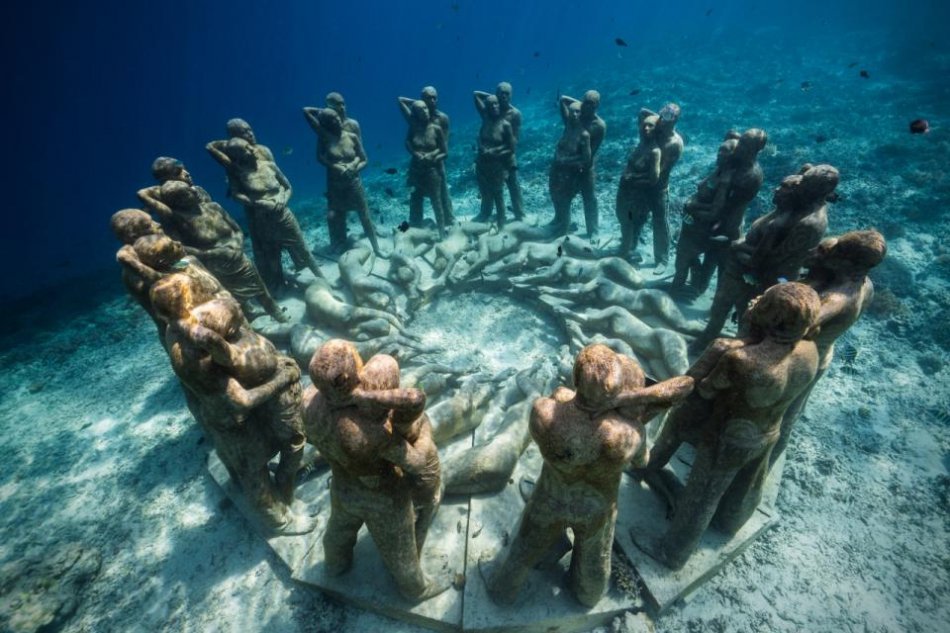
British environmental artist Jason deCaires Taylor recently completed his latest work, and it’s his most stunning to date—The Sculpture Coralarium, presented as the world’s first semi-submerged tidal gallery space. Located in the middle of the Maldives’ largest developed coral lagoon at the island resort Fairmont Sirru Fen Fushi, the partially submerged art gallery is primarily experienced in the water and guests are invited to snorkel and swim their way to the installation. The museum’s human-like sculptures, built of marine-safe neutral-pH material, are designed to promote coral growth and provide additional marine habitat over time.

The Sculpture Coralarium is the Maldives’ first underwater museum and took approximately five months to install. The artwork begins with a long swimming pool that transects the beach and leads to a coral-lined pathway submerged in the sea. The 100-meter walkway is “sea-scaped” with endemic planted corals and serves as the symbolic threshold to another world. An additional five- to ten-minute swim reveals a submerged staircase, which connects to a cuboid six-meter-tall building with stainless steel walls. The walls themselves have coral-inspired laser-cut openings to allow water and marine life to pass through. The front facade is typically submerged to a median tide of three meters.



A series of Jesmonite human-like sculptures were placed on the roof of the cuboid structure, while over a dozen more sculptures can be found on plinths at various heights and submerged at differing degrees. The sculptures were made using casts of the local population and combined with organic coral and plant-inspired forms. The sculptures will promote the growth of coral reefs.
“The underwater realm of the installation includes a series of children looking up towards [the] surface of the sea. This poses questions about the threat of climate changeand sea levels rising and the consequences for future generations,” reads the project statement. “Overall the installation aims to draw all the elements of life on earth together, to portray a system where all components are dependent on each other, humans and the environment in coexistence, a leveling of relationships. The Coralarium becomes a portal or interface to the wonders of the underwater world.”



Dive into the clear blue waters off the coast of Lanzarote and you could find yourself face-to-face with an eerie crowd of motionless humanlike figures. These hauntingly beautiful sculptures are the work of artist Jason deCaires Taylor, who recently installed the first phase of his incredible underwater concrete artworks for Museo Atlantico, Europe’s first undersea sculpture museum in the Canary Islands. The museum’s unique and permanent collection will raise awareness of the threats facing our world’s oceans as well as the ongoing refugee crisis, while promoting the growth of a large-scale artificial reef.
Located 15 meters beneath the surface, the contemporary Museo Atlantico will feature approximately 300 eco-friendly sculptures as well as an underwater botanical garden filled with sculptural hybrids of people and native Lanzarote plants. One of the most striking installations is ‘The Raft of Lampedusa,’ a sunken boat carrying 13 refugees. The artwork is a modern interpretation of Théodore Géricault’s 1818 French Romanticist oil painting ‘The Raft of Medusa’ that depicts the horrific scene following the wreckage of the French naval frigate Méduse.



The Museo Atlantico’s main installation is ’The Rubicon,’ which comprises a group of 35 people—the figures are inspired by Lanzarote citizens, many of who wield smartphones and electronics to symbolize the “Instagram generation”— walking towards a wall, described by the curators as “a point of no return or a portal to another world.”



Via: inhabitat.com, underwatersculpture.com
Life & style
